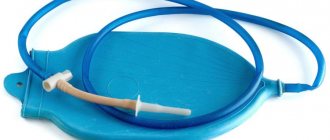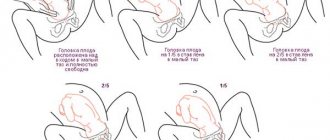Normally, labor begins 38 weeks after conception, but a full-term baby can be born at 36 or 42 weeks. The date of planned birth is counted in different ways: from the date of possible conception or from the first day of the last menstruation, so the gestation period may vary.
The first signs of labor may appear 2-3 weeks before the onset of labor. But it is better to go to the maternity hospital directly during regular true contractions with an interval of 5-7 minutes in order to avoid medical stimulation and give birth naturally.
What does a woman most often experience before giving birth?
- irritability, fear and anxiety, which is caused by hormonal changes in a woman’s body;
- nausea, loss of appetite or, conversely, increased appetite, vomiting, upset stomach, as well as weight loss of 1-2 kg, which can occur several weeks or days before birth and is associated with the functioning of the hormonal system;
- a slight increase in body temperature and chills very often accompany the onset of labor;
- pain in the lower abdomen, lower back or sacrum, which are pulling or spasmodic in nature and are provoked by displacement of the vertebrae in the sacrum and increased excitability of the nervous system;
- excitability of the uterus, which is manifested by increased sensitivity and tension of this organ, this happens periodically, first 1-2 times a week, then several times a day;
- false contractions are training contractions of the uterus that begin to bother a woman several weeks before giving birth and differ from true contractions in that they do not have a strict frequency and can be eliminated with the help of relaxing procedures, walking, and a warm bath;
- true contractions are regular, cramping pain that occurs before childbirth and is accompanied by dilatation of the cervix.
Signs of the onset of labor are also brown discharge from the genital tract and prolapse of the abdomen before childbirth.
Increased temperature as a sign of infection
Along with stress and preparation for childbirth, complications in the form of acute respiratory or intestinal infections, or exacerbation of chronic pathologies are also quite possible. In these conditions, fever will be one of the symptoms of malaise. If there was contact with a sick child or adult, and signs of a cold appeared - headache, runny nose and cough, sore throat - most likely the increase in temperature is associated with ARVI. It is especially dangerous to get the flu just before childbirth; this can lead to serious problems during the birth of the baby.
Also, fever with malaise and pain in the abdomen, nausea and vomiting is possible with food toxic infections, acute intestinal infections or inflammation of the stomach or intestines (exacerbation of chronic diseases).
Fever is typical for genitourinary infections and the development of cystitis, pyelonephritis, then there will be changes in the urine, increased urge to urinate, burning and unpleasant odor of urine.
Important!
All accompanying symptoms of fever are a reason to immediately consult a doctor. You may have to give birth in an observation department, where there will be a separate boxed ward and delivery room, as well as special monitoring of mother and baby.
How does the plug come out before childbirth?
A few days before the onset of labor, a woman begins to experience discharge from the genital tract, reminiscent of the onset of menstrual bleeding. This is the release of mucus, which protected the uterus and the fetus in it from infection from the vagina.
The discharge of the mucus plug before childbirth can occur quickly, as if the plug had actually popped out (this is typical if the fetus is heavy), or it can flow out slowly over several days. This process signals the dilation of the cervix and the onset of labor.
Elena's story: I was in labor for 15 hours with a temperature of 38.2
- Share on Facebook
- Share on VKontakte
- Share on Odnoklassniki
What did the participant in the “9 Months” during childbirth? What difficulties did you have to endure and what problems did you struggle with?
Lena (Just_me) will tell us how it happened
*****
I decided that I was waiting for 41 weeks and was going to give up.
I really wanted labor to begin on its own, and not with a puncture of the bladder or an examination on a chair with passion, but the PDR passed, the clinic absolved itself of all responsibility by issuing a referral to the maternity hospital, and my baby was still in no hurry to come to my dad and me.
In general, I decided that I was waiting for 41 weeks and was going to give up (already at the 2nd maternity hospital, and not at the 6th). Waking up on the morning of April 15, i.e. exactly at 41 weeks, I sadly realized that nothing had changed overnight, and I had to take the bags and head to the maternity hospital.
This made the mood worse, the weather was also disgusting, it was raining, it was cloudy, even the radio in the car for some reason was acting up, and there was a continuous hiss on all channels.
So we drove to the maternity hospital in silence: I didn’t want to talk, and my husband was sympathetically silent, probably didn’t know what to tell me that could somehow cheer me up or cheer me up (and probably there was nothing like that at that time).
A formidable female doctor said that I was irresponsible
In the emergency department, when they saw my referral, issued a week ago, they yelled at me in the most severe way (well, of course... a week ago I would not have been their client, but I’m creating inconvenience for them).
The formidable woman who carried out the inspection said that I was irresponsible, and she would recommend that I be deprived of money for timely registration (oh, horror!! what grief!!).
In general, my examination was still the same, but at some point her expression changed, and she told me that it turned out that I was already having contractions. I just didn’t feel them then. That’s how I was immediately sent from the emergency room to the prenatal room.
The staff there was much nicer and friendlier. During the examination on the chair, my waters broke, they turned out to be green, so in the future there was increased attention to me.
I had to gather all my will into a fist and “go into childbirth” even more actively
The dilatation was going well, I was not stimulated, they offered painkillers, but I refused it - I wanted the most natural process possible. Everything went as I wanted: the birth began on its own, there was no extra force, I was breathing correctly and relaxing, concentrating as much as possible on the birth, but in the middle of the process I started having terrible chills (I didn’t even think it was possible to shake like that), it turns out , my temperature jumped to 38 and 2.
This fact significantly complicated the birth, because I could no longer walk during contractions and lay covered in blankets. But childbirth is something that you can’t stop and put off until tomorrow because you don’t feel well.
I had to gather all my will into a fist and “go into childbirth” even more actively, as Julia taught. It probably worked out well, because the midwife admired how patient I was, she even praised me to the doctors in the delivery room, in general she did a lot for me - she was so supportive, encouraging, I was very lucky that I got on her shift.
And finally the delivery room! The time was already approaching one in the morning (and they brought me to the prenatal room at about 10 in the morning). A little more suffering, and my baby was born. Exactly at one o'clock in the morning.
*****
A couple of days ago we were already discharged from the maternity hospital . Dashulik and I were met by a huge company! I was even a little confused when I saw the crowd of people greeting me: my husband, parents, representatives of Child BY, friends with my whole friendly family. It was incredibly nice!!
If on the 15th I went to the maternity hospital in a disgusting mood, then I was discharged in the best possible mood!!
PS there were 100 balloons waiting for us at home. The new daddy tried...
Project organizer:
General partner of the project:
Happiness starts from childhood!
Project partner:
Read also:
The second baby of the project is already home!
“9 months” close up: Elena (Just_me)
Discussing on the forum:
Project "9 months"
Family catalog:
Waiting for the birth
Did you like the article? Share it with your friends on social networks!
If you want to share your personal experience, ask a question to a specialist, or talk about a painful issue, write to us at
- Share
- Share
- Share
Tags: Projects and competitions, About pregnancy and childbirth, Personal experience, Project “9 months”
When does your stomach drop?
3-4 weeks before the planned date of birth, the pregnant woman’s belly seems to slide down, this happens gradually and slowly. At the same time, the stomach changes somewhat in shape and decreases in size.
As the abdomen lowers, it becomes easier for a woman to breathe and eat as the diaphragm is released.
When symptoms of impending labor appear, a woman should rest more and save her strength for the main period of pregnancy - the birth of the baby.
Is it necessary to lower the temperature before giving birth?
If these are stress reactions or preparation for childbirth and the formation of precursors, such a temperature does not require treatment or the use of antipyretics, it disappears on its own in sleep and is unstable . You can help by taking plenty of warm liquid, sedative decoctions and infusions in consultation with your doctor. It is important to rest more and be in the fresh air.
If you suspect ARVI or any other illness, you should immediately call a doctor at home to determine the diagnosis and resolve the issue of hospitalization in the maternity hospital. Often it is there that active treatment measures will be carried out and the issue of delivery will be decided. You cannot take any medications without a doctor’s permission, nor can you reduce your temperature with aspirin or analgin.
Alena Paretskaya, pediatrician, medical columnist
just today
( 51 votes, average: 4.24 out of 5)
Herpes on the lips during pregnancy: how to treat
Why does the stomach drop before childbirth?
Related Posts
Specialists
Makatsaria Alexander Davidovich
Obstetrician-gynecologist, famous scientist, founder of clinical hemostasiology.
It will help you plan and maintain your pregnancy if you have had cases of fetal loss, thrombosis, obstetric complications or blood coagulation disorders. You can also contact your doctor for a transcript of hemostasis tests.
Egorova Elena Borisovna
Obstetrician-gynecologist of the highest qualification category.
Specializes in peritoneal factor of infertility in women and management of problematic pregnancies.
It will provide effective help if, before conception, you were diagnosed with adhesions, endometriosis, erosion or other pathologies of the cervix.
Akinshina Svetlana Vladimirovna
Obstetrician-gynecologist, hemostasiologist with an academic degree.
Pregnancy management S.V. Akinshina will help avoid severe complications: gestosis, placental insufficiency, fetal loss syndrome.
The doctor's expertise includes hemostasis disorders and immunological infertility.
Bitsadze Victoria Omarovna
Gynecologist-hemostasiologist, professor, doctor of medical sciences.
The doctor's profile is management of high-risk pregnancies, including in women with genetic thrombophilia and a tendency to spontaneous bleeding. Develops effective treatment regimens for infertility associated with autoimmune pathologies and hemostasis disorders.
How to measure
Measuring an animal's temperature is easy. An electronic or mercury thermometer is used.
The following manipulations are performed:
- The thermometer readings are reset to zero.
- The tip is lubricated with Vaseline.
- The pet is placed on its side and calmed down.
- The thermometer is inserted into the anus to a depth of about 2 cm.
- The electronic thermometer is held for 1 minute, the mercury thermometer for 5 minutes.
The option of measuring when the dog is standing is allowed. But for inexperienced dog breeders, measuring indicators in this way is problematic.
When performing the procedure for the first time, it is important to create a comfortable environment for the pet and reward it with treats..
If everything is done correctly, the animal will be calm about such manipulations. If discomfort is caused once, it will be difficult to measure body temperature in the future because the dog remembers the pain.
How and when to treat?
If a woman complains of an increase in temperature, the doctor is obliged to examine her - take a blood test, do an ultrasound, take a smear of vaginal flora for analysis, and do a general urine test. In the absence of signs of disease, treatment is not prescribed, since the increase in temperature is considered physiological. This reaction of the body before childbirth, according to statistics, is characteristic of approximately 15% of pregnant women.
If the causes of fever are still painful, you should try to eliminate them before giving birth. Childbirth itself is a big burden on the female body. If there is an opportunity not to aggravate this burden, why not take advantage of it?
For ARVI, a woman is prescribed plenty of fluids, bed rest, fresh juices and fruits, and healthy sleep. In this case, medications are not prescribed or symptomatic medications are recommended - separately from a runny nose, cough or headache. The doctor should choose medications taking into account the “interesting” position of the patient.
Genital and genitourinary infections require treatment with antibacterial drugs. Before birth, antibiotics do not have such a strong teratogenic effect on the fetus as in the third trimester. If prescribed by a doctor, they may well be used to stabilize the condition of a future woman in labor.
In what cases is high temperature a symptom of illness and not of imminent labor?
The temperature before the delivery process may indicate an acute illness or the activation of a chronic illness if it lasts for a long time (more than a week) and often reaches more than 37.5°C.
In this case, it is important to pay attention to indirect signs:
- for colds, upper respiratory tract infections - fever, migraine, fatigue and apathy, cough, nasal discharge,
- for genitourinary infections - difficulty urinating, swelling, impaired urine outflow,
- inflammation in the abdominal organs - excessive sweating, chills, vomiting, abdominal pain, increase in body temperature to 39.5°C.
Possible causes of hyperthermia
An increase in temperature of 0.5–0.9 units above 37 °C in most cases is normal for 15–20% of pregnant women in the 38–39th week of gestation. In rare cases, it may be caused by premedication and anesthesia before the start of labor.
In most cases, prenatal hyperthermia indicates the beginning of an acute period of an infectious disease (respiratory, genitourinary, etc.). The most dangerous is an increase in temperature caused by infection of the placenta or amniotic fluid. Some infectious pathogens enter the fetus's body through the general bloodstream, reduce the reactivity of its immune system, and in some cases can provoke premature birth.
The earliest warning sign is considered to be prolapse of the pregnant woman's abdomen.
What does it look like?
About 2-3 weeks before giving birth, you will notice that your belly has dropped. Often this happens suddenly, somehow suddenly. Of course, the height of the uterine fundus, which increases weekly by 1 cm and by the 37th week is about 37-40 cm (if there is only one baby in the uterus), suddenly decreases by 2-3 cm in a few hours.
Of course, this does not go unnoticed: breathing becomes easier, the shape of the abdomen changes - it becomes flat, sloping at the top. As one of the pregnant women put it, at first, when the stomach is high, “at least put a cup and saucer and drink tea.” And at the moment of the realization of the precursor, which we called “prolapse of the abdomen,” the uterus immediately becomes lower by 2-3 cm. You can no longer put down a cup and saucer. A palm can now easily fit between the chest and stomach.
Why is this happening?
The lower segment of the uterus becomes softer and stretches before childbirth. The child descends, pressing his head tightly against the bony rim of the small pelvis, and the stomach becomes lower.
Signs of a harbinger:
- the appearance of pulling sensations in the lower abdomen. Shooting pains may appear in the perineum and legs, because the child puts all his weight on the muscles, ligaments and nerves.
- easier breathing (the pregnant uterus no longer puts so much pressure on the lungs)
- decreased motor activity of the baby.
It is likely that a decrease in your child's motor activity may puzzle or frighten you. The child is pressed against the bone ring of the small pelvis with his head, as a result of which he stops turning and can only move his arms and legs. So the decrease in movements is understandable and normal.
And the purpose of the harbinger
is clear: fixing the head prevents the baby from turning over and facilitates the beginning of the birth process. The birth canal for the baby is already three centimeters complete! And only ten will remain in labor.
In the case of the pelvic position, the lowering of the presenting part does not occur. Due to its large size and softness, the baby's butt cannot be inserted into the bony ring of the mother's pelvis.
And what should come after?
After the third stage of labor - the departure of the placenta - the postpartum period begins, which begins after the expulsion of all placenta and lasts until the uterus and other genital organs of the female are completely restored.
An alarming signal during this period is bleeding for more than 3 weeks, depression, fever. This may indicate that puppies or placenta remain in the uterus and bleeding has begun.
In the first two to three days, the temperature may rise to 39.9˚C, this is associated with the arrival of milk.
What can cause temperature changes
- Infection during pregnancy. These are all kinds of infectious diseases: colds, runny nose, etc. Infection of amniotic fluid, placenta and uterus. This is very dangerous because it affects the development of the fetus. Not the best option for the development of infections during pregnancy is the presence of chronic diseases: sinusitis, diseases of the genitourinary system, etc.
- Stress. Any experiences that result in stress have a huge impact on changes in body temperature. This reaction of the body serves as protection for the expectant mother and her baby.
- Anesthesia and the use of anesthetics at any week of pregnancy. The fact that they only cause a slight increase in temperature should be taken into account.
The influence of the disease on the birth process
High temperature during childbirth, as a rule, does not affect the course of the normal labor process. Complications that arise (weak labor, etc.) are not caused by acute influenza or ARVI, but by the pathology of pregnancy and the presence of risk factors for the development of these complications. During childbirth, a woman expends a huge amount of energy. And even if childbirth began against a background of high temperature, then after it, taking into account the body’s energy consumption, the body temperature drops to normal and even slightly reduced numbers.
They try to conduct childbirth with influenza and ARVI against the background of intoxication using anesthesia. This allows the woman in labor not to waste energy during contractions and to push fully in the second stage of labor.
After childbirth, a woman with manifestations of ARVI and influenza is given (or continues to be given) treatment, which will now be aimed at preventing postpartum complications (such as endometritis, suppuration of perineal sutures, if they were placed, etc.).
With a normal, uncomplicated course of the postpartum period, after recovery, mother and baby are discharged home.
"Duck Walk"
The center of gravity shifts, and the woman compensatory tilts her shoulders back when walking. When a pregnant woman walks, she places her legs not in one line, as was the case before pregnancy, but slightly apart, thereby increasing the area of support. This is important in order to better retain the increased volumes. There is nothing wrong with this, this is a typical gait of a woman before childbirth. If this is the first pregnancy, then the woman will walk like this for 2-4 weeks. During subsequent pregnancies, the stomach drops literally on the eve of childbirth.
Is it possible to change this indicator with the help of medications?
If your body heat increases or decreases during, before or after childbirth, do not self-medicate. Contact your doctor immediately or invite him to your home ; perhaps the dog is cold or too hot; you need to wrap it up, lower the temperature in the room, or wipe the dog with cool water. In this case, you can use any medications only after the recommendation of a doctor.
Preventive measures
Before giving birth, you should not visit crowded places, this risks a viral disease, which is completely unnecessary now. Also, you should not refuse vaccinations against influenza - pregnant women and children are given special vaccines that are free of impurities. Even if a vaccinated woman gets the flu, the illness will be milder without severe complications.
To prevent intrauterine infection, it is important to remember that after the mucous plug, water, and when the cervix begins to prepare for childbirth, sexual contact, swimming in the pool, and taking a bath are prohibited in order to prevent infection from entering the genital tract, and from there into the uterine cavity .
Shortly before giving birth, you should calm down, pull yourself together, and consult a psychologist if you cannot cope with your anxiety on your own. Don't forget to take vitamins, eat well and rest.
A specialist talks about how to properly prepare for childbirth, even in the presence of a fever, in the following video.
medical reviewer, psychosomatics specialist, mother of 4 children
Portal for parents about children









